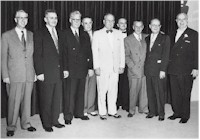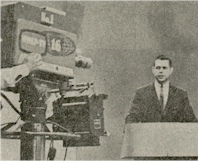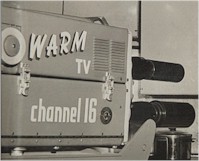A Brief History of WNEP-TV
Part 1

Television stations today are technological marvels. Computers, digital components,
transmitters of unimagined power, and machines that can make anything we dream a reality.
WNEP-TV will be celebrating its 50th anniversary soon. We thought it would be interesting
to look back, and see how it all began.
Five Stations started it all
The Scranton/Wilkes-Barre TV market was born on January 1st, 1953 when WBRE-TV signed on
the air at 3pm. With this first signal the race was on. Six months later WDAU-TV in
Scranton, signed on. Three months after that, on September 16th, 1953, WILK-TV hit the
air. In January of 1954, WARM-TV owned by a group headed by Former Governor William
Scranton began broadcasting. Last, and as it turned out, least, was WVUE-TV from Scranton.
WVUE-TV lasted only 9 months before it ceased operations and its license was bought by
WDAU-TV. It would be 20 years before another station would be added to our market.

WILK-TV signs on. The Governor of Pennsylvania, the Mayor of Wilkes-Barre, and other
dignitaries join WILK-TV owners Thomas Shelbourne and Dr. Roy Morgan. |
Typically, the stations in the market operated from 3pm until midnight. On the day that
WILK-TV signed on, they were scheduled to begin the festivities at 2pm....getting the jump
on the other two operating stations. But the whole thing almost never took place. The
engineers working on the transmitter had the signal up and running by noon of that day, so
they went to lunch. At lunch they asked the restaurant owner to turn on the TV, so they
could see the test signal and how it looked....it looked good. About an hour before the
ceremony, they looked up from their lunch and saw snow on the screen! Skipping lunch (and
paying) they rushed back to the tower and managed to re-establish the signal at 1:50 pm.
Putting a station on the air was simple. Getting a network signal from New York to
Scranton was hard. Back then you couldn’t just pick up the network signal off a
satellite. The engineers of the station had to make it up as they went along. Often using
hand-made equipment from old radio parts, the engineers came up with “hops”, or
re-transmissions, from mountain top to mountain top. They adapted microwaves to carry the
network signal from the top of the Empire State Building to a reception tower in Effort,
Pa., about 45 miles east of Wilkes-Barre. From there the signal was relayed to Penobscot
Mountain, the site of our transmitter. It wasn’t the most reliable system in the
world, and often the Effort tower had to be re-directed to accept a signal from
Philadelphia. Ice and snow at both towers affected the signals and many times the engineer
on duty had to climb up the tower and chip the ice off with hammers. Talk about hazardous
duty!

WNEP-TV News Anchor Bob Carroll in 1966 (photo courtesy The Scranton Times)
Past Newswatch 16
6pm Anchors
John VonBergen
Tom Bigler
Roy Goshorn
Bob Carroll
John Glawe -- Marie Carpentier
John Foster -- Marie Carpentier
Ed Martelle -- Liz Pursell
Gary Essex -- Liz Pursell
Gary Essex -- Susan Blake
Gary Essex -- Cheryl Toney
Gary Essex -- Jacqueline Boulden
Nolan Johannes -- Jacqueline Boulden
Nolan Johannes -- Karen Harch
Nolan Johannes -- Marisa Burke
Frank Andrews -- Marisa Burke
Mike Lewis -- Marisa Burke |
Both WILK-TV out of Wilkes-Barre and WARM-TV out of Scranton, were ABC Network
affiliates. Since the two stations used the same network signal, they would sometimes
share their signal with each other when weather turned bad. But this was hardly a
courtesy. Occasionally, the engineer on duty would flash his own station’s call
letters on the signal sent to the other station. This would make it on the air and
infuriate the opposing General Manager.
Networks, also in their infancy, provided little programming for the local stations. Back
then networks signed on at 8pm and carried programming until 11pm. Filling the time before
and after was up to the local station, and WILK had plenty of ideas. Cooking shows with
local women, kid shows after school, local politicians, and any kind of game show
imaginable all took turns filling time and attracting viewers. In those days not many
people watched television, so the shows didn’t have a lot of money to work with.
Often two or even three different programs would use the same set, and everybody helped
put on the show. A big break for local television came with the McCarthy hearings on
un-American activity. The hearings introduced television to people in many ways and led to
higher ratings even after the hearings were over. People began to get in the habit of
watching TV.

WARM-TV camera used on the show "At Home with Janet" in the 1950s |
That didn’t mean that stations flourished. In fact, WILK and WARM were both losing
money, but because they were each part of local radio stations, they stayed on the air. In
1955, the owners of WILK and WARM (the two ABC affiliates) decided to merge the two
stations. A company from Buffalo, NY, Transcontinental stepped in to make things legal,
and on January 1st, 1956 the struggling stations joined to form WNEP-TV. WNEP still holds
the license for WILK-TV 34, even though our primary signal is the WARM-TV 16.
Continue to "WNEP
History Part 2" -->
![]()
